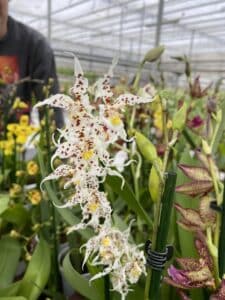BLOG: GROWER REPORT INCA ORCHIDS
André van der Goes; a grower in heart and soul. He went in search of dynamism and challenges, and found the exact crop he was looking for during an internship in Brazil. Now, many years later, I’m chatting with him at his nursery. Read how a grower of exclusive orchids tries to balance his heart as a true fan with commercial reality.
Why did you become a grower, and why do you grow orchids?
“I come from a growers’ family. My brother and sister racked their brains trying to decide what they wanted to study, but I never had any doubts; I was going to horticultural school. After I finished my studies, I didn’t want to go to work at my dad’s nursery straight away. He grew cut cymbidiums, which I thought lacked dynamism. I went to work for a large pepper grower, but realised that this world of mass production and automation wasn’t for me either. When my dad decided he was willing to change course with me, we started a nursery with exclusive orchids. I became interested in orchids during an internship in Brazil, where I ended up at a nursery with Oncidium and Miltonia.
Well… I got what I wanted. Plenty of challenges and dynamism! Growing these types of orchids is still pioneering work. We have around 50 different species at the nursery. You have to get to know each species by conducting lots of tests. Sometimes I think the fully-automated pepper cultivation system wasn’t that bad after all.”
The company and your brand has been called Inca Orchids for a number of years. What was the inspiration behind the name?
“I want to take the customer into the tropical mountain rainforest of the Andes, where beautiful orchids live under the canopy of trees at an altitude of 1,600 metres. You’re surrounded by the sounds of the jungle, and notice that it can actually get quite chilly at night. Finally, hidden in the forest, you find the old Inca temple you’ve been looking for.
There’s a reason I like to link this story to our orchids. Everyone knows the phalaenopsis, so it no longer needs a story to sell itself, but orchids such as Brassia, Oncidium and Zygopetalum don’t have such a reputation. I can understand the success of the Phalaenopsis with its long flowering time and the fact that it easily grows new flowers. Even so, the mystical, the jungle feeling, the amazing colours and patterns, the most fantastic fragrances… these are the dominion of other orchids.”
Are there any other strains you’d like to grow?
“The world of orchids is incredibly rich, and I’m always experimenting with various beautiful species. As a result, my heart as a true fan regularly comes into conflict with commercial reality. If I want to successfully place a plant on the market, it has to meet certain conditions. It has to be suitable for the climate in my nursery, it mustn’t grow too tall, and the leaves mustn’t have too many marks. There is so much beauty, but I have to keep my feet on the ground. I worked on ‘Disa uniflora’, a beautiful African orchid, for a while, but I had to stay stop to myself when I saw that only 10 plants in 100 develop flowers.
However, all the searching and testing has of course revealed species that I can eventually grow successfully. For example, a dark blue Zygopetalum and an orange Epidendrum will be launched soon. These are both beautiful plants, but both have no name yet. Just smell that Zygopetalum, what a wonderful fragrance!”
“There is so much beauty, but I have to keep my feet on the ground”

“I’m a fan of the fragrance produced by Miltonia, a plant which is already blessed with beautiful flowers. My new favourite, however, is the Odontoglossum Naevium, a new strain which brings a smile to my face. It produces fringed, white, spider-like flowers with yellow centres and dark red dots, and a heavenly fragrance!”
Have you got any tips for garden centres?
“Don’t leave exclusive orchids on the table next to Phalaenopsis. The jungle effect comes into its own much better if these orchids are placed between tropical foliage plants such as Calathea, Aglaonema and Alocasia. Explain that proper care is important, but not difficult at all.
The plants are healthiest when they are supplied with a number of flowers open, since they have then passed the phase that demands a lot of energy at the nursery where conditions are ideal, and they can flower for at least another 6-10 weeks.
What’s your connection with Javado?
“I see you as an exporter with your own distinct style. You’re big enough to be a major player in the market, but not so big that things become impersonal. I’ve known the team for years; people with a passion for plants, that works really well.”
What are your future plans?
“I want the orchid species I grow to get the appreciation they deserve. When determining prices, we in the business are used to looking at cold facts such as the number of branches per plant, the height, and the pot size. However, consumers look very differently at these miracles from the plant world. They see a mysterious plant with the most wonderful flowers and fantastic fragrances.
To convince the trade of the quality and potential of our orchids, we’re growing more and more orchids in 9-cm pots. These are attractive, full plants, with the volume that we occasionally used to deliver in 12-cm pots. We also continue to grow in 12-cm pots, of course. These plants are extra thick and fill the pot well.
In this way, I’d like to convince the consumer and the trade of the value of these unique plants.”
Published on: 20 May 2021